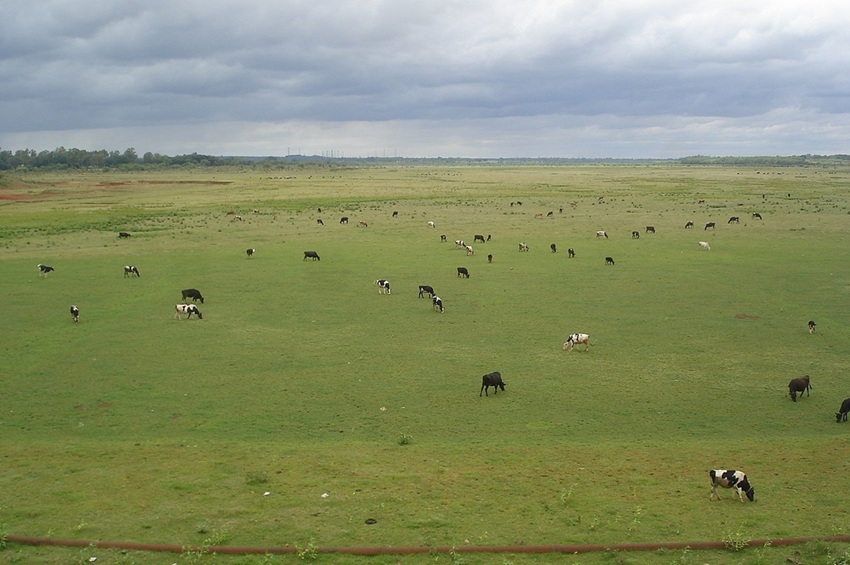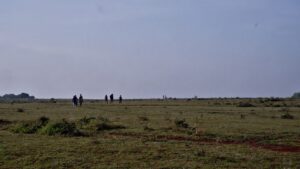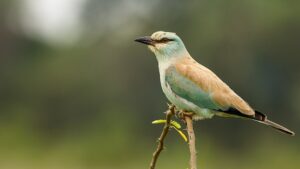A Grassland Gets A Lifeline, Offers A Lesson
Oct 17, 2025 | Pratirodh Bureau
Cattle graze in the Hesaraghatta grassland (Image by Planemad via Wikimedia Commons)
- Rare birds, butterflies, mammals, and reptiles thrive in one of Bengaluru’s richest grasslands.
- The grassland soaks monsoon runoff, recharges groundwater, and buffers urban expansion.
- Over 5000 acres are now protected, showing how peri-urban ecosystems can be conserved while allowing responsible use by local communities.
On the northwestern edge of Bengaluru, beyond the buzz of the tech city, the wind whistles across the golden-green grasslands. Smooth-coated otters glide along the lakeshore, devouring fish, while raptors slice through the blue beyond. The famed grassland around Hesaraghatta lake — Bengaluru’s first planned drinking water source — got a new lease of life earlier this year when the Karnataka state government declared it a conservation reserve.
Once dismissed as wasteland and used as a film backdrop, the area now notified as the Greater Hesaraghatta Grassland Conservation Reserve now protects 5,678 acres of land after more than a decade of environmental activism, ecological surveys, and bureaucratic deliberations. It meant saving the grassland from real estate interests, a film city project, and some misplaced notions of conservation. Its notification under the Wildlife (Protection) Act, 1972, issued by the State Board for Wildlife and ratified by the state cabinet protects this niche from an unrelenting urban sprawl.
Biodiversity treasure trove
A grassland is an ecosystem of grasses and small plants, with few trees breaking its low skyline. Rain falls just enough for the grass, but not enough for the forests. The savannahs of Africa, the steppes of south-eastern Europe, the pampas of South America, all fill that ecologically unique space between forest and desert, the world’s most open and life-filled landscapes.

“Hesaraghatta is an open, semi-wet, freshwater-grassland-marshland, a unique kind of ecosystem and the last remaining grassland-savannah-wood complex in the Bengaluru region,” said Chethan Kumar Gandla, a wildlife expert and assistant professor at Christ University in Bengaluru. “Spanning an area of about 1,912 acres of lakebed surrounded by grassland, it hosts a unique landscape and exceptional biodiversity — around 235 species of birds, 400 species of insects, and 100 species of butterflies recorded in the area suggest the biodiversity richness in the area.”
The biodiversity is quite unique, Gandla noted. “It includes the rare butterfly species, lilac silverline (Cigaritis lilacinus), birds including European roller (Coracias garrulus), lesser florican (Sypheotides indicus), and sightings of rare birds like Egyptian vulture, steppe eagle, etc. In addition, 55 species of plants, around 10 species of mammals including leopard, jackals, Indian fox & slender loris, seven species of reptiles, and 13 species of frogs and toads, including a remarkable sighting of Sholiga’s narrow-mouthed frog (Microhyla sholigari).”
It is a site for several migratory birds from Europe, Central Asia, and the Himalayas, including several species of raptors, as official data show, with special mentions of greater spotted eagle (Aquila clanga), a vulnerable bird as per the IUCN Red List, and lesser florican, which is critically endangered.

“The place should be conserved for its ecological value,” said Vishwanath Srikantaiah, a water conservationist and a trustee of Biome Environmental Trust, an organisation assisting communities to find water and sanitation solutions. These grasslands receive an average of 750 to 800 mm of annual rainfall, significantly less than Bengaluru’s average. The average rainfall for Bengaluru of late is over 1,000 mm. The laterite soil beneath retains moisture and aids grass growth, unlike aquifers that aid tree growth, he explained.
The government notification described the area as a crucial catchment for reviving groundwater levels, aiding recharge and improving the water table — benefiting thousands of farmers in surrounding villages. It also serves as a natural sponge, soaking up monsoon runoff. The grassland forms part of the larger catchment of the Arkavathy river and Thippagondanahalli reservoir, a drinking water source, as well as the Hesaraghatta lake.
Golden grass
The value of the grassland lies not so much in its role as a catchment for the lake, but in its intrinsic ecological qualities, Srikantaiah pointed out. Rainfall varies across grasslands from season to season, year to year, and grass grows with the rain. Some blades stay short, under a foot. Some reach seven feet. Roots also stay short, extending only three to six feet into the soil. The rain and roots keep the soil rich.
For Bengaluru — a city where lakes are shrinking or just vanishing, wetlands are encroached upon, and groundwater is dipping — the protection of Hesaraghatta signals not just an ecological reprieve but also a shift in how urban nature is understood and valued, Srikantaiah said. “Generally, conservation is seen as planting trees; once in Hesaraghatta, too.”
Grassland or wasteland?
The bad press that the grasslands get comes from a misunderstanding of their ecology, as scientists argue. Jayashree Ratnam, who is currently director of the wildlife biology and conservation programme at the National Centre for Biological Sciences, Bengaluru, has written in a 2016 paper: “The savannahs of Asia remain locally unrecognised as distinctive ecosystems, and continue to be viewed as degraded forests or seasonally dry tropical forests. These colonial-era legacies are problematic because they fail to recognise the unique diversity of Asian savannahs and the critical roles of fire and herbivory in maintaining ecosystem health and diversity.” Herbivory means the act of animals feeding on plants.
Critics argue that the forest-centric bias in policy and management has also influenced scientists and cartographers, leading them to continue labelling India’s tropical savannas as tropical dry forests or degraded forests.
Conservation meets local needs
Grasslands actually cover twice the area fit for crops, yet their role in feeding the world is often overlooked, as research shows. Grazing animals turn grass — inedible to humans — into food and energy without stealing from our fields. Grassland meat and milk may leave a smaller carbon footprint than factory-farmed livestock, they note.
Besides, grasslands hold roughly a third of the world’s land-based carbon and serve as vital soil carbon sinks. Recent studies show that greater plant diversity boosts soil organic carbon by increasing carbon flow to roots and enhancing microbial contributions to soil carbon storage.
The conservation reserve model, introduced under Section 36A of the Wildlife (Protection) Act, 1972, offers a balance – it enables state governments to protect ecologically significant landscapes while allowing local livelihoods and existing land uses to continue. In the case of Hesaraghatta, this designation ensures that no private land acquisition or eviction is involved.
Peri-urban grasslands often slip between forest and farmland, overlooked in policy. As experts note, these fast-changing, semi-natural lands feed cities with water, green spaces, and orchards. Yet urban sprawl eats into them, shrinking green fields, choking open spaces, and draining water.
In this context, declaring the grassland a protected area is a welcome step.
(Published under Creative Commons from Mongabay India)
